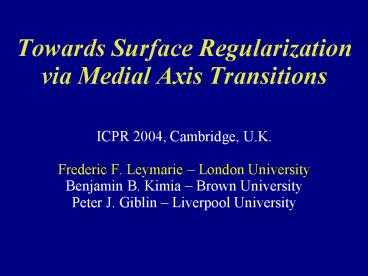Towards Surface Regularization via Medial Axis Transitions - PowerPoint PPT Presentation
1 / 20
Title:
Towards Surface Regularization via Medial Axis Transitions
Description:
Towards Surface Regularization via Medial Axis Transitions ... shape: smooth away less important features while preserving significant ones in the vicinity. ... – PowerPoint PPT presentation
Number of Views:72
Avg rating:3.0/5.0
Title: Towards Surface Regularization via Medial Axis Transitions
1
Towards Surface Regularization via Medial Axis
Transitions
- ICPR 2004, Cambridge, U.K.
- Frederic F. Leymarie London University
- Benjamin B. Kimia Brown University
- Peter J. Giblin Liverpool University
2
Outline
- Surface and object regularization background
- Medial scaffold for 3D shape representation
- Transitions of the medial axis
- Algorithm
- Results
- Future work
3
Surface and object regularization
- Regularize shape smooth away less important
features while preserving significant ones in the
vicinity. - Classical smoothing cannot distinguish between
features and noise. - Recent anisotropic curvature smoothing methods
are parameter sensitive, require a careful
treatment of surface boundaries, and well-defined
surface meshes (and normal fields) Tasdizen02,
Hildebrandt04.
4
Our goal develop a hierarchical shape
representation to regularize shape
- Study the dynamics of the medial axis under
perturbations. - Requires a representation of the MA as a graph.
5
Achievements
- Take input as unorganized point clouds or
polygonal meshes. - Can deal with objects under real scans, process
partial surfaces. - Robust under different resolutions, acquisition
conditions.
- Do not require a closed surface mesh or
voxelization, i.e., no inside/outside, skeleton
can be a graph with loops (not a tree). - Do not over-simplified the extracted skeletal
graph. - Regularization based on a comprehensive analysis
of the the medial structure w.r.t. topological
changes under shape perturbations.
6
Shape representation From the Medial Axis (MA)
to the Medial Scaffold (MS)
Blum (1960's 70's) Propagation vs. Contact
with disks
2000 Shock singularities Contact
typology (Kimia, Giblin, et al.)
7
Shape representation From the Medial Axis (MA)
to the Medial Scaffold (MS)
- 3D Five types of points from
contact theory Giblin-Kimia PAMI04 - Sheet A12
- Links A13 (Axial), A3 (Rib)
- Nodes A14 (Voronoi vertices) , A1A3
Leymarie01 Keep only singular points of the
flow (radius) to build a graph.
8
Computing the Medial Scaffold (MS)
Leymarie-Kimia CVPR03 Visibility
constraints together with clustering leads to
efficiency in computing the graph (linear in
practice in the number of input generators)
9
Transitions of the MA
Study the topological events of the graph
structure of the MA under perturbations and shape
deformations.
- Singularity theory (Arnold, Bogaevsky, since the
1990's) - In 3D, 26 topologically different perestroikas
of linear shock waves.
Perestroikas of shocks and singularities of
minimum functions, I. Bogaevsky, 2002.
10
Transitions of the MA
Study the topological events of the graph
structure of the MA under perturbations and shape
deformations.
- Transitions of the MA (Giblin Kimia, ECCV
2002) - Under a 1-parameter family of deformations, only
seven transitions are relevant.
A15
A1A3-II
(compression-like)
(pulling apart-like)
A5
A14
(ridge merging-like)
(compression-like)
11
Transitions of the MA
Study the topological events of the graph
structure of the MA under perturbations and shape
deformations.
A1A3-I
(protrusion-like)
A12A3-I
(protrusion on axial curve)
A12A3-II
(protrusion moving thru an axial curve)
12
Scaffold Regularization
- Transition removal, i.e., remove topological
instability - Smoothing
Green A1A3 nodes, Pink A14 nodes
Blue A3 links, Red A13 links
13
2D Scaffold Regularization
- Transition removal, i.e., remove topological
instability - 2D Boundary Smoothing ordered by scale
(Tek Kimia JMIV 2001).
Iterative removal of MA branches, ordered by
boundary support (i.e., how much of the contour
is represented), coupled with local boundary
model adjustment, results in corner enhancement
and small perturbations' smoothing.
14
3D Scaffold Regularization
- Transition removal, i.e., remove topological
instability - 3D Boundary Smoothing ordered by scale.
- Only (3) transitions pertaining to protrusions
are considered here.
(1) Detect Axial-Rib loops in the medial
scaffold. (2) Support on the boundary is
approximated as the volume subtented by V-shaped
hinges which define a cap-like region in between
the axial and rib curves delimiting a potential
transition.
15
3D Scaffold Regularization
(1) Compute full Scaffold from unorganized point
clouds. (2) Symmetries pertaining to the
interaction of nearby samples are used to mesh
the data into surface patches (S) Leymarie
Kimia, DIMACS 2003. (3) Remaining graph
structure is the Medial Scaffold. (4) Detect
Axial-Rib loops in the medial scaffold. (5)
Walk along axial curves for each loop
identifies contact curves on S delimiting
protrusions. (6) Build smooth cut-off
patches. (7) Rank order loop structures. (8)
Proceed with transition removal.
16
3D Scaffold Regularization
Sherd data 50K from laser scans
Significant ridges useful for pot matching and
reconstruction (a 3D puzzle) in digital
archaeology applications.
SHAPE Lab. www.lems.brown.edu/shape/
17
3D Scaffold Regularization
Knot data 10K random samples
Towards generalized cylinders
18
Towards 3D Object Recognition
Graph matching via graduated assignement (to be
presented at 3DPVT, Greece, Sept. 2004, Chang,
Leymarie Kimia) a solution to the Global
Registration problem.
David data 20K and 30K reduced sample sets
(ground truth 50K)
Validation against ground truth (object
dimension 69x69x76) average sq. dist.
0.000005
19
Conclusions - Limitations
- Perturbations smaller than contact sphere radius
are not visible from the graph structure alone. - Complementary to recent anisotropic smoothing
methods. - Four remaining transitions not yet usable for
surface regularization.
Data from Cyberware Inc.
20
Conclusions - Advantages
- Hierarchical representation is built-in.
- Scale represented to distinguish large features
from small ones and rank accordingly. - Reconstruction of the shape from its skeleton is
always possible (exact to approx.). - Robustness Structural information from the
scaffold is more reliable than surface samples. - Generalized axes of elongated objects, and ridges
are explicit represented. - Shape deformations are now handled.
Data from Cyberware Inc.































